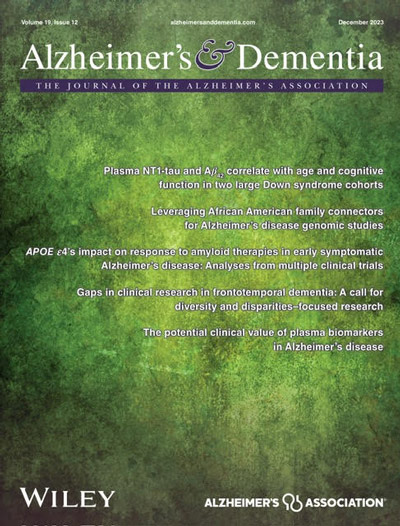Traumatic brain injury, changes in plasma amyloid, tau, and neurodegenerative biomarkers, and dementia risk
Abstract
INTRODUCTION
Long-term trajectories of plasma biomarkers in relation to incident traumatic brain injury (TBI) and whether TBI modifies associations of biomarkers with dementia risk are unknown.
METHODS
One thousand fifty Atherosclerosis Risk in Communities (ARIC) study participants without prior TBI had amyloid beta (Aβ42/Aβ40), phosphorylated-tau181 (pTau181), neurofilament light (NfL), and glial fibrillary acidic protein (GFAP) measured from plasma collected in 1993 to 1995, 2011 to 2013, and 2016 to 2019. Linear mixed-effects models estimated biomarker trajectories associated with TBI and Cox proportional hazards models determined if TBI modified associations of biomarkers with incident dementia through December 31, 2020.
RESULTS
After the median time of incident TBI, Aβ42/Aβ40 levels remained lower for 9.3 years, and pTau181, NfL, and GFAP remained elevated for 8.5, >13.8, and 12.7 years, respectively. There was evidence of additive interaction by TBI in associations of log2NfL with incident dementia (p = 0.024).
DISCUSSION
TBI alters trajectories of plasma biomarkers of neurodegeneration for approximately a decade after the injury and modifies associations of NfL with dementia risk.
Highlights
- Our findings provide evidence that TBI fundamentally alters trajectories of plasma biomarkers of AD-related pathology, neuronal degeneration, and astrogliosis for approximately a decade after the injury.
- Further, our findings also suggest that an incident TBI event adds to and interacts with ongoing neurodegenerative processes to increase the risk of later life dementia.
- These results suggest that the pathologic processes underlying post-TBI dementia are heterogeneous, that individuals with preclinical changes in neurodegenerative biomarkers may be more susceptible to TBI (i.e., that associations are bidirectional), or a combination thereof.





 求助内容:
求助内容: 应助结果提醒方式:
应助结果提醒方式:


